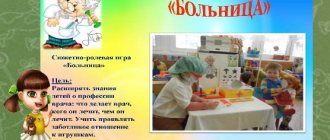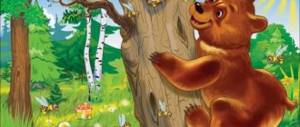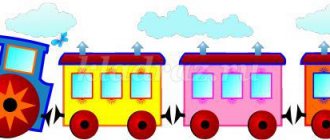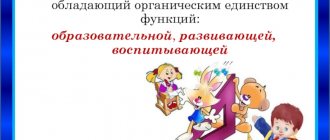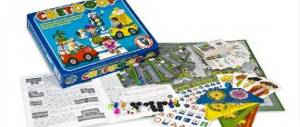How to combine intelligence and leisure? The game "Paint" is great for this. This is a very old, popular game that has survived more than one decade, and maybe even a century. It has survived, survived and does not lose its relevance.
The easiest way to teach color names is through games. You can get both pleasure and knowledge. If children already know a certain number of names of colors and shades, then this game will allow them to consolidate and expand their existing knowledge and at the same time have fun running around.
The outdoor game “Colors” has other names and several options. “Paints” is a group game in which children of the same or different ages can participate. The age of the players is from 4 to 10 years.
Standard version of the game Paints
Preparations for the game:
For the game “Paints”, one leading seller and one buyer-monk are selected from among the participants, the rest of the children become paints. Paint participants sit in a circle or in a gazebo, sometimes children stand in a line. The seller quietly (in his ear) tells everyone what color of paint corresponds to him. Children remember their color. The buyer monk should not know the colors of the paints.
Progress of the game
:
A monk comes to a paint store and addresses the seller:
I'm a monk in blue pants, I came for paint. - For which one?
The monk names the color of the paint (for example, blue). If there is no such paint, the seller replies:
There is no such thing! Jump along the blue path, on one leg, you will find boots, wear them, and bring them back!
The tasks for a monk can be different: gallop on one leg, walk like a duck, squat, or something else.
If the named paint is present in the store, then the seller answers the monk:
There is one! - What is the price? - Five rubles (The monk loudly slaps the seller’s palm five times).
At the last clap, the named “paint” jumps up from its place and runs around the gazebo or line of other children. The monk tries to catch up with her. If he catches up with the paint, then he himself becomes the paint, and the caught paint participant becomes a buyer-monk and the game continues.
If the monk was unable to catch the paint, then the game starts over.
Game "Paints": rules
Paints are a game with rules. This is also why it is good for older preschoolers and elementary school students: it fosters arbitrariness.
Option for children 4-5 years old
For such kids the game is simplified. This is how we play. The optimal number of players is 6-7 children. It is advisable for children to sit on something: a beam, a bench, etc.
First, we select a “buyer” of paints. The buyer is a “turkey”. Let's introduce an element of theatricality (kids love it). The turkey is an important buyer: fat, rich. If there are several people who want to be a “turkey,” we use a counting rhyme. For example, little Violetta suggested this:
One two three four five. A mother cloud was walking across the sky. She took Little Cloud with her by the hand. Who doesn't believe is him. Get out of the circle.
You just need to make sure that the counting is used correctly: the word or a small group of words falls exactly on the player. "Buyer" has been selected.
Each child chooses a paint color and loudly announces it to everyone. It happens that small children forget the chosen color. And those around you can help - remind you. This is firstly, and secondly, kids hear other names for colors of “paints”, remember them and use them in the future.
"Turkey": knock-knock. All in unison: who is there? "Turkey": turkey. All in unison: why did you come? "Turkey": for the paint. All in unison: for which one? “Turkey”: names paint.
Everyone counts to three in unison. “Kraska” runs away, and the “turkey” catches her. If he touched it, it means he caught it and takes it to his house. If the “paint” is clever and managed to escape, then it returns to the paint store with the words: “Knock, knock! I'm in the house."
If the “turkey” named the color of “paint” that is not there, everyone tells him in unison: “Jump along (the color of the missing paint is called) the path on one leg.” You can draw a path, or you can gallop around the bench.
Here we must take into account that many children of this age do not know how to jump on one leg. Therefore, you can run or jump on two legs. In a word, depending on the circumstances.
Why do kids speak in unison? Little children are impatient. Arbitrariness is not sufficiently formed. It is difficult for them to listen to another, to wait for someone to finish speaking, especially in the heat of the game.
If there are a lot of people who want to run, and they express their resentment that the “turkey” does not choose them for a long time, then this version of the game is possible. The caught “paint” becomes a “turkey” buyer, and the “turkey” comes up with a color for itself and joins the rest of the “paints”.
Second version of the game “Paints” with a devil player
In this version of the game, the Devil played instead of the buyer's monk. This game is reminiscent of Hali-Halo. The devil also comes to the store to buy paints and has the following dialogue with the seller:
Knock Knock! - Who's there? “I’m a devil with horns, with pies, a bump on my forehead, and a fried mouse in my pocket!” - What did you come for? - For paint! - For which one?
After the paint was named and it was present in the store, the devil paid the seller by clapping his palm. With the last blow, the paint jumps up and runs away, and the devil at this moment must quickly utter any agreed words.
Thanks buddy, have a pie!
As soon as the devil said the last word, the color stops. The devil must estimate the distance to the runaway paint in steps.
It seems that everything is simple, he said how many steps he walked, and if the devil reached the paint, then he won. But this game has its own tricks. The steps for the devil are not entirely ordinary.
Steps may be
- normal steps
- giant steps,
- Lilliputian steps,
- brick steps (heel to toe),
- camel steps (step and spit).
The devil is told what steps he should take towards the paint. If you walk and touch the paint, then the devil himself becomes paint.
I hope you and your children will enjoy the game PAINTS and have fun playing it.
In the 19th - early 20th centuries, a game was widespread in Russia, which they liked to play at Christmas time, especially on Christmas Eve, that is, on the night of December 24 to 25, from December 31 to January 1, from January 6 to 7 (dates are given in the old style). At the core of the game
lies the Christian idea of Christmas as a holiday that signifies the victory of the forces of light and good over the forces of darkness and evil.
The former are personified in the game
in the form of an angel, the latter in the form of a devil.
Genetically, the game
apparently goes back to nativity scenes, widespread in the folk culture of Ancient Russia (as you know,
mummered carolers
walked along the street, carrying an image of a nativity scene over their heads).
Over time, the ritual content disappeared from the game
, leaving only the dramatic conflict.
On long winter
evenings, especially all night on Christmas Day,
playing
with
paints
was very useful for young people and served as fun entertainment.
Two masks are determined by drawing lots - an angel and a devil. Damn according to the terms of the game
he immediately leaves the hut on the street, in the entryway, or, if the house is large, into another room, where he puts on makeup and dresses up.
At this time, the angel distributes paints
, that is, he names one for everyone - red, black, white, bluish-brown, etc. The distribution of paints must end before the devil arrives.
He, dressed up more funnily, knocks on the door with a stick, saying: “Knock, knock at the gate.” The angel allows him to enter. He appears, jumping, grimacing, waving a stick - in a word, imitating the devil.
The
angel
Who are
you ? " I want to get married.” — “What colors
?”
The devil calls paint. If there is one, he takes its “owner” by the hand and takes it aside, thus making him a member of his team. The names of the paints were given very different, for example, by the color of the berry (lingonberry, raspberry, cherry, sea buckthorn), by the combination of colors (red-brown, white-pink, etc.), generally unexpected (black with a gleam, “like a macaque back”, etc.). So what to name without knowing in advance all the available paints
, was almost impossible.
But most of the colors were still named. Why? Because, firstly, the range of colors in nature is not so unlimited, and secondly, the players
knew each other well and had a clear idea of who could come up with what.
One way or another, it always turned out that the devil took almost all the colors
.
The angel has the right to play back a certain part of the colors. In accordance with his rank and spiritual position, he has a serious conversation with the players who have gone to hell. The seriousness of the conversation is emphasized in every possible way. Neither he nor the player
They have no right to smile, much less laugh. Although the game situation is conducive to just that. Moreover, the devil behind the angel’s back continues to make all sorts of grimaces, comical body movements - in general, he interferes with having a soul-saving conversation.
And the conversation goes like this:
“Where have you been?” asks the angel, the next player. “At the priest’s.”— “What did you eat?”—“Prosvira.”—“What did you cut with?”—“With a knife.”—“What’s there (pointing up)? - “Heaven.” - “And here?” - “Earth.” - “What’s here?” - “Devil.” - After this word, the angel crosses himself, spits, and instructs his interlocutor not to be seduced by the devil’s machinations.
If the interlocutor (this or that paint) keeps a serious face on the linden, this means that he has passed the test and is returning “to the true path” - to the angel, to the colors that were not guessed and named. If the tested player
couldn't stand it, smiled, burst out laughing - he couldn't stand being on the
team
.
When all players have been tested, the composition of the teams is determined. The angel and the devil take a stick and begin to pull it in their direction, they are helped by the corresponding commands; whoever wins will win.
This is how this fun game ends.
How to combine intelligence and leisure? The game "Paint" is great for this. This is a very old, popular game that has survived more than one decade, and maybe even a century. It has survived, survived and does not lose its relevance.
The easiest way to teach color names is through games. You can get both pleasure and knowledge. If children already know a certain number of names of colors and shades, then this game will allow them to consolidate and expand their existing knowledge and at the same time have fun running around.
The outdoor game “Colors” has other names and several options. “Paints” is a group game in which children of the same or different ages can participate. The age of the players is from 4 to 10 years.
Outdoor game "Colors". material
Standard version of the game Paints
Preparations for the game:
For the game “Paints”, one leading seller and one buyer-monk are selected from among the participants, the rest of the children become paints. Paint participants sit in a circle or in a gazebo, sometimes children stand in a line. The seller quietly (in his ear) tells everyone what color of paint corresponds to him. Children remember their color. The buyer monk should not know the colors of the paints.
Progress of the game:
A monk comes to a paint store and addresses the seller:
“I’m a monk in blue pants, I came for paint.” - For which one?
The monk names the color of the paint (for example, blue). If there is no such paint, the seller replies:
- No such thing! Jump along the blue path, on one leg, you will find boots, wear them, and bring them back!
The tasks for a monk can be different: gallop on one leg, walk like a duck, squat, or something else.
If the named paint is present in the store, then the seller answers the monk:
- There is one! - What is the price? - Five rubles (The monk loudly slaps the seller’s palm five times).
At the last clap, the named “paint” jumps up from its place and runs around the gazebo or line of other children. The monk tries to catch up with her. If he catches up with the paint, then he himself becomes the paint, and the caught paint participant becomes a buyer-monk and the game continues.
If the monk was unable to catch the paint, then the game starts over.
Second version of the game “Paints” with a devil player
In this version of the game, the Devil played instead of the buyer's monk. This game is reminiscent of Hali-Halo. The devil also comes to the store to buy paints and has the following dialogue with the seller:
- Knock Knock! - Who's there? “I’m a devil with horns, with pies, a bump on my forehead, and a fried mouse in my pocket!” - What did you come for? - For paint! - For which one?
After the paint was named and it was present in the store, the devil paid the seller by clapping his palm. With the last blow, the paint jumps up and runs away, and the devil at this moment must quickly utter any agreed words.
- Thanks buddy, have the pie!
As soon as the devil said the last word, the color stops. The devil must estimate the distance to the runaway paint in steps.
It seems that everything is simple, he said how many steps he walked, and if the devil reached the paint, then he won. But this game has its own tricks. The steps for the devil are not entirely ordinary.
Steps may be
normal steps
giant steps,
Lilliputian steps,
brick steps (heel to toe),
The devil is told what steps he should take towards the paint. If you walk and touch the paint, then the devil himself becomes paint.
I hope you and your children will enjoy the game PAINTS and have fun playing it.
